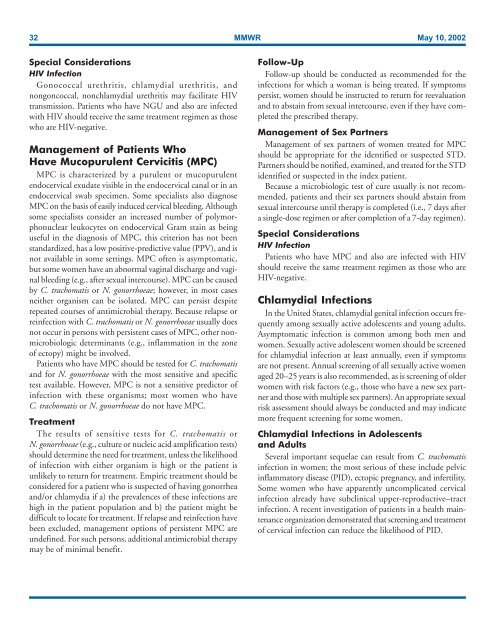You also want an ePaper? Increase the reach of your titles
YUMPU automatically turns print PDFs into web optimized ePapers that Google loves.
32 MMWR May 10, 2002<br />
Special Considerations<br />
HIV Infection<br />
Gonococcal urethritis, chlamydial urethritis, and<br />
nongoncoccal, nonchlamydial urethritis may facilitate HIV<br />
transmission. Patients who have NGU and also are infected<br />
with HIV should receive the same treatment regimen as those<br />
who are HIV-negative.<br />
Management of Patients Who<br />
Have Mucopurulent Cervicitis (MPC)<br />
MPC is characterized by a purulent or mucopurulent<br />
endocervical exudate visible in the endocervical canal or in an<br />
endocervical swab specimen. Some specialists also diagnose<br />
MPC on the basis of easily induced cervical bleeding. Although<br />
some specialists consider an increased number of polymorphonuclear<br />
leukocytes on endocervical Gram stain as being<br />
useful in the diagnosis of MPC, this criterion has not been<br />
standardized, has a low positive-predictive value (PPV), and is<br />
not available in some settings. MPC often is asymptomatic,<br />
but some women have an abnormal vaginal discharge and vaginal<br />
bleeding (e.g., after sexual intercourse). MPC can be caused<br />
by C. trachomatis or N. gonorrhoeae; however, in most cases<br />
neither organism can be isolated. MPC can persist despite<br />
repeated courses of antimicrobial therapy. Because relapse or<br />
reinfection with C. trachomatis or N. gonorrhoeae usually does<br />
not occur in persons with persistent cases of MPC, other nonmicrobiologic<br />
determinants (e.g., inflammation in the zone<br />
of ectopy) might be involved.<br />
Patients who have MPC should be tested for C. trachomatis<br />
and for N. gonorrhoeae with the most sensitive and specific<br />
test available. However, MPC is not a sensitive predictor of<br />
infection with these organisms; most women who have<br />
C. trachomatis or N. gonorrhoeae do not have MPC.<br />
Treatment<br />
The results of sensitive tests for C. trachomatis or<br />
N. gonorrhoeae (e.g., culture or nucleic acid amplification tests)<br />
should determine the need for treatment, u<strong>nl</strong>ess the likelihood<br />
of infection with either organism is high or the patient is<br />
u<strong>nl</strong>ikely to return for treatment. Empiric treatment should be<br />
considered for a patient who is suspected of having gonorrhea<br />
and/or chlamydia if a) the prevalences of these infections are<br />
high in the patient population and b) the patient might be<br />
difficult to locate for treatment. If relapse and reinfection have<br />
been excluded, management options of persistent MPC are<br />
undefined. For such persons, additional antimicrobial therapy<br />
may be of minimal benefit.<br />
Follow-Up<br />
Follow-up should be conducted as recommended for the<br />
infections for which a woman is being treated. If symptoms<br />
persist, women should be instructed to return for reevaluation<br />
and to abstain from sexual intercourse, even if they have completed<br />
the prescribed therapy.<br />
Management of Sex Partners<br />
Management of sex partners of women treated for MPC<br />
should be appropriate for the identified or suspected STD.<br />
Partners should be notified, examined, and treated for the STD<br />
identified or suspected in the index patient.<br />
Because a microbiologic test of cure usually is not recommended,<br />
patients and their sex partners should abstain from<br />
sexual intercourse until therapy is completed (i.e., 7 days after<br />
a single-dose regimen or after completion of a 7-day regimen).<br />
Special Considerations<br />
HIV Infection<br />
Patients who have MPC and also are infected with HIV<br />
should receive the same treatment regimen as those who are<br />
HIV-negative.<br />
Chlamydial Infections<br />
In the United States, chlamydial genital infection occurs frequently<br />
among sexually active adolescents and young adults.<br />
Asymptomatic infection is common among both men and<br />
women. Sexually active adolescent women should be screened<br />
for chlamydial infection at least annually, even if symptoms<br />
are not present. Annual screening of all sexually active women<br />
aged 20–25 years is also recommended, as is screening of older<br />
women with risk factors (e.g., those who have a new sex partner<br />
and those with multiple sex partners). An appropriate sexual<br />
risk assessment should always be conducted and may indicate<br />
more frequent screening for some women.<br />
Chlamydial Infections in Adolescents<br />
and Adults<br />
Several important sequelae can result from C. trachomatis<br />
infection in women; the most serious of these include pelvic<br />
inflammatory disease (PID), ectopic pregnancy, and infertility.<br />
Some women who have apparently uncomplicated cervical<br />
infection already have subclinical upper-reproductive–tract<br />
infection. A recent investigation of patients in a health maintenance<br />
organization demonstrated that screening and treatment<br />
of cervical infection can reduce the likelihood of PID.


